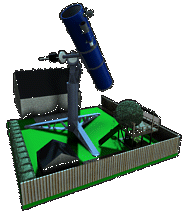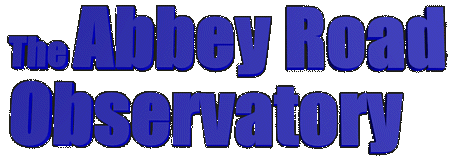 |
 |
|
Astrophotos 2009-2010 |
Go back to HOMEPAGE
 |
 |
|
Astrophotos 2009-2010 |
Go back to HOMEPAGE
|
November 18, 2009 Finally, a clear night! At last I can get my telescope out and do some looking around. My universal digital camera adapter came a couple weeks ago, and I have not yet had a chance to try out some afocal photography (ie. taking pictures through the eyepiece). Well, setting up the scope was fine, I even put it out early so it could cool down. However I had a number of other problems, like the tracking motor seems to be too fast...I guess I'll have to do that mod that moves the potentiometer to the front panel. Also, the universal camera adapter was really fidgety and not so "universal". After friggin' with it for an hour I gave up and just snapped some hand shots of my frosty little friend. I did take one not to bad shot in manual mode with full aperture and longest shutter speed (f/2.8, ISO 64, 30sec) on my point-and-shoot. I think it didn't turn out too bad! The red on the scope was from my head lamp, which I totally forgot about! In the end I liked the effect. I ended up staying outside another hour and a half exploring M42 and making sketches in my journal...don't need an adapter for that! |
| November 23, 2009 I've been thinking about the whole camera mount thing, and the clamping to the eyepiece idea isn't great (this is how the Celestron universal digital camera adapter I bought works). I thought up an idea of bolting something directly to an extension tube that I can insert ahead of the eyepiece...that should be much sturdier, and independent of the e.p. in case I want to change it. I've put the extension tube on order from Agena AstroProducts...add another project to the list! |
| March 24, 2010 The view of the moon was so cool through my LX10 tonight, I decided to try to take some pictures by just holding my point-n-shoot camera up to the eyepiece. I played with the camera in manual mode, adjusting the f-stop and shutter speed. The focus was locked at infinity. The pictures are not great, but it's a start. |
| April 24, 2010 This was the annual OAOG Astro Day, an all day event held at the Chapters parking lot over at Silver City in Ottawa, Canada. The clouds made the viewing not great, but the great turn-out made the event a great success nonetheless. Here are some pictures from during the day. |
| May 25, 2010 After a so-so weekend for viewing, tonight was lovely and clear, with above average transparency and average seeing. The moon was nearly full so much of the sky was washed out by its brightness. I did toy around a bit with my Sony DSC-N1 point-n-shoot again, just holding it up to the eyepiece and snapping. I was using my 40mm eyepiece on my LX-10 telescope. The first two pictures were with the camera on manual mode, at two different aperture and shutter speed settings. The later two were with the camera on full auto. I am curious how these images will look once I get a solid way for mounting the point-n-shoot to the telescope. |
| June 29 - July 11, 2010 The family and I spent 2 weeks up at my wife's family cottage, near the village of Sheenboro, on the Quebec side of the Ottawa River just up-river a bit from Petawawa, ON. I brought my new ED80 apo refractor since there was no room for the LX10 on the way up! I did a lot of observing from the beach, with some spectacular nights. During my time up there I managed to snap a few pictures with my Sony DSC-N1point and shoot. Just playing around! Every night began with a very prominent Venus reasonably high in the west. I especially like the shot of my setup on the beach at sunset that has Spica (Alpha Virginis), Saturn, Mars, and Venus all in a line. All the star shots are made simply with the camera lying on the table, f/2.8 + 30sec shutter speed. The image of the moon and the bright object to the right was a pleasant surprise I had one evening. I was waiting a bit until the moon had risen above the tree line to observe it before bed, when I noticed the very bright star. When I looked at it through my telescope it was no star, it was Jupiter! The close-up moon shot was taken through my ED80 + 6.7 UWA eyepiece, just hand holding the camera and using full auto. While on the beach one day we saw some amazing lenticular rays right overhead, very neat. There were of course many lovely sunsets looking out across the river, the image here just being one of them. The first star shot is of Cygnus rising above the tree line behind me. The image does no justice to the magnificent view of the Milky Way that I had each night. The next two images are of Scorpio in the south, right over the town of Petawawa; the first as the camera saw it with all the light pollution, the second with my Astro Hutech IDAS LPS-P2 light pollution filter draped over the camera lense. Can you see the difference?...I can see the difference! You can even make out M8 (the Lagoon Nebula) in the mid-left part of the image. The next image is of Aquila and surrounding Milky Way (again the image does the view no justice!) with a passing satellite in the frame. The final image is of the Summer Triangle; Deneb to the left, Vega up top, and Altair in the lower right. It took me about 10 shots to get all three stars in the same image! Wow, what a great 2 weeks vacation! |
| August 12-14, 2010 Everyone has been so excited about this year's Perseid meteor shower. It is near to a new moon, and the forecast for viewing is very good. I myself have bought into the excitement and have made an effort to get out and see at least some of the show. On Thursday night (12th) I set up my LX10 in the yard as well as an experimental rig I've been playing with; a Toshiba IB-WK11A network camera. I have been using two of these video cameras as baby monitors in my kids' rooms. They are 1.45 mega pixel cameras, and have great low light performance. I was curious how these cameras would perform strapped on the end of my telescope, so I bought a third one off Ebay. I don't have the telescope adapter put on yet, but I was able to just set it up with its factory lens looking at the sky. You can control the shutter speed down to 4sec, which results in a video image that I estimate is roughly 4 times more light sensitive than my naked eye. With a FOV of 57deg, it nicely covered the area of sky from the Pleaides over to Cassiopea. I rigged up a button to the "alarm in" jack allowing me to save images when I wanted. Then I sat there in my lawn chair and stared at the heavens. Over the course of 1 hour (from 4am to 5am Aug. 13th) I saw 10 meteors (not bad for being in the middle of the city with mag 3 skies) and captured 3 with the video camera. Friday night (13th) my family and I headed up to my wife's family farm, again in the Sheenboro, Quebec area. The forecast was for reasonably clear skies so I brought my network camera along, as well as a pair of binoculars. I did a little stargazing from their lawn...pretty good view (~mag 5.5 skies), but not as amazing as in early July (~mag 6 to 6.5). I also set the timer function up on the network camera so it would automatically record an image every 10 seconds, from 3am to 5am. I was a little disappointed as it only captured 3 meteors in that time, along with 3 satellites. I guess it is better than nothing! |
Go back to HOMEPAGE
Last updated: 02-Mar-12
|
Copyrights to all content from the webpages hosted here belongs to Jim Thompson. Nov. 2009. |